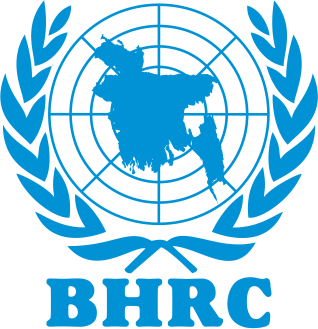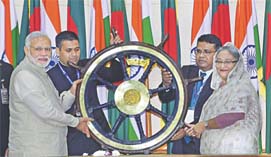

|
EDITOR
|
Editorial
‘Fortnightly’
পাক্ষিক |
|
সম্প্রতি সংবাদপত্রে দুইটি
শিশুর বিষয়ে প্রতিবেদন ছাপা হয়েছে। কর্মরত
দুইটি শিশু হাতুড়ি-বাটাল নিয়ে পরিশ্রমের কাজে
রত। শিশু দুইটিকে নিয়ে প্রকাশিত ছবিটির নিচেই
প্রকাশিত হয়েছে একটি রিপোর্ট। রিপোর্টের
শিরোনাম “পেটের দায়ে শিশু বয়সেই শ্রমিক ওরা”।
রিপোর্টার লিখেছেন ‘স্কুল বা কোনা শিক্ষা
প্রতিষ্ঠানেই ওদের লেখাপড়া করার সুযোগ হয়নি।
শুধু লেখাপড়া কেন, কোন বিষয়েই প্রাতিষ্ঠানিক
শিক্ষা পায়নি ওরা। কারণ, পরিবারের দারিদ্র্য।
দারিদ্র্যের কারণে পেটের দায়ে ওরা এখন শ্রমিক-
শিশু শ্রমিক।” শিশু শ্রম একটি মানবাধিকার
লঙ্ঘনজনিত কাজ। তবে শিশুদের বেঁচে থাকার নিুতম
ব্যবস্থা করার দায়িত্ব রাষ্ট্রের। |
Bangladesh has
nothing to worry about NRC, Modi tells Hasina

Human Rights Report
Prime Minister
Sheikh Hasina holds bilateral talks with her Indian
counterpart Narendra Modi in the sidelines of UNGA
at Kennedy Room of Lotte New York Palace in New
York, US on September 27, 2019 Focus Bangla
The foreign minister said the entire gamut of
bilateral concerns like the issues of NRC and
water-sharing of the common rivers, including Teesta,
came up for discussions between the two prime
ministers.
Indian Prime Minister Narendra Modi has assured his
Bangladesh counterpart Sheikh Hasina that the
National Register of Citizens (NRC) in India will
have no impact on Bangladesh and there is no need to
be worried about it. Modi made the assurance at a
bilateral meeting held between him and Sheikh Hasina
at Kennedy Room of Lotte New York Palace on Friday.
"The talks [between Hasina and Modi] were held in a
very cordial and friendly environment," said Foreign
Minister Dr AK Abdul Momen while briefing reporters
after the meeting.
The foreign minister said the entire gamut of
bilateral concerns like the issues of NRC.
or ethnicity.
.BHRC & IHRC Human
Rights Report on September 2019 in Bangladesh
Total 169 persons killed in
September 2019
Human Rights Report:
The documentation section of
Bangladesh Human Rights Commission (BHRC) and
International Human Rights Commission-IHRC jointly
furnished this human rights survey report on the
basis of daily newspapers and information received
from its district, sub-district and municipal
branches. As per survey it appears that 169 peoples
were killed in September, 2019 in all over the
country. It proves that the law and order situation
is not satisfactory. Bangladesh Human Rights
Commissions extremely anxious about this situation.
In the month of September, 2019 average 5 people
were killed in each day. The Law enforcing agencies
and related Govt. departments should be more
responsible so that percentage of killing May be
brought down to zero level. To institutionalize the
democracy and to build human rights based society
the rule of law and order must be established
everywhere. Through enforcing rule of law only such
violation against human rights can be minimized.
It appears from documentation division of BHRC:
Total 169 peoples killed September 2019
Killing for dowry 4, killing by family violence 30,
Killed due to social discrepancy 36, Political
killing 7, Killed by Law enforcing authority 28,
Killed due to doctor negligence 5, Abduction 7,
Assassination 9, Mysterious death 38, Women &
Chilled killed due to rape 5, Killed by Acid
throwing 1
Killed by several accidents: Killed by road accident
228, Suicide 15
Besides victims of torture:
Rape 53, Sexual Harassment 14, Torture for Dowry 4,
Journalist torture 2, Acid throwing 1.
Making cities
child-responsive
S. M. Rayhanul
Islam
Human Rights Report:
Shaping urbanization for children: A handbook on
child-responsive urban planning, Published by
UNICEF, 2018, Pages: 192, ISBN: 978-92-806-4960-4
In an era of rapid urbanization, over half the
world's people - including more than a billion
children - now live in urban areas. Urban areas -
cities and towns - of course, offer great potential
to secure people's life. Children (the most
vulnerable groups of any community) in urban areas
are often better off than their rural counterparts
in relation to higher standards of health,
sanitation, protection, education, recreation and so
on. But urban advances have been uneven, and
millions of children across the world, in
marginalized urban settings, have to confront daily
challenges and deprivations of their rights.
Analysis of the main urban contexts demonstrates
that urbanization does not necessarily ensure
sustainable urban environments for all children. An
estimated 300 million of the global population of
slum dwellers are children, who suffer from multiple
deprivations, live without a voice and have no
access to land, housing and basic services. For
children, it means unhealthy and unsafe
environments, limited options for walking and
playing, limited connectivity to social networks,
services and local economy. Hence, given the global
trend in urbanization, there is significant
potential to engage with children in the
decision-making processes that affect their physical
urban environment, their interaction with urban
resource systems and shape their behaviour.
The UNICEF publication "Shaping urbanization for
children: a handbook on child-responsive urban
planning" presents concepts, evidence and technical
strategies to bring children to the foreground of
urban planning. It calls all urban stakeholders
(i.e. urban planners, city governments, private
sectors, civil society organizations, and so on) to
invest in child-responsive urban planning,
recognizing that cities are not only drivers of
prosperity, but also of inequity. By focusing on
children, this publication provides guidance on the
central role that urban planning should play in
achieving the Sustainable Development Goals (SDGs),
from a global perspective to a local context, by
creating thriving and equitable cities where
children could live in healthy.
Ending violence
against children
Human Rights Report:
A statistical analysis
of violence against children, Published by UNICEF,
ISBN: 978-92-806-4767-9
The Convention on the Rights of the Child (CRC) and
other international human rights treaties guarantee
that children everywhere should live free from all
forms of violence. Nevertheless, violence remains an
all-too-real part of life for children around the
world - regardless of their economic and social
circumstances, culture, religion It is proved that
children who have been severely abused or neglected
are often hampered in their development, experience
learning difficulties and perform poorly at schools.
They may have low self-esteem and suffer from
depression, which can lead, at worst, to risky
behaviors and self-harm. Witnessing violence can
cause similar distress. Children who grow up in a
violent household or community tend to internalize
that behavior as a way of resolving disputes,
repeating the pattern of violence and abuse against
their own spouses and children. Beyond the tragic
effects on individuals and families, violence
against children carries serious economic and social
costs in both lost potential and reduced
productivity.
The UNICEF publication "Hidden in Plain Sight: A
statistical analysis of violence against children"
presents the latest statistics on violence against
children, drawing on data from 190 countries around
the world. By examining global patterns of violence
as well as attitudes and social norms, this evidence
based report sheds light on an issue that has
remained largely undocumented. Its objective is to
use data to make violence against children and its
many ramifications more visible, bringing about a
fuller understanding of its magnitude and nature and
offering clues to its prevention.
Over the last decade, recognition of the pervasive
nature and impact of violence against children has
grown. Still, the phenomenon remains largely
undocumented and underreported. This can be
attributed to a variety of reasons, including the
fact that some forms of violence against children
are socially accepted, tacitly condoned or not
perceived as being abusive.
Child health in jeopardy over random use of antibiotics
Human Rights Report:
Hasibul Karim lives
with his family in capital's Goran area. His
7-year-old daughter Rodela suffers from cold and
cough often. Sometimes she gets high fever lasting
four to five days. Karim went to a pediatrician, who
prescribed seven-day antibiotic course for Rodela
alongside normal medicine for fever.
"Children naturally don't like to take medicine.
Moreover it is very hard to complete the seven-day
antibiotic course for them. Whenever we force her to
take the antibiotic, she began crying, compelling us
to leave the course incomplete, which, I think, is
creating more risk for her," Hasibul Karim said.
Antibiotics are very effective to treat infection,
but it is losing its effectiveness through the
random use.
According to a research conducted by International
Centre for Diarrhoeal Disease Research, Bangladesh
(icddr'b), the tendency of buying and taking
antibiotics without prescription is growing rapidly.
After feeling a little better, many people stop the
course on its halfway. The researchers fear that if
this bad practice continues, one day these
antibiotics will not work anymore as the intake of
inadequate amount of antibiotics is affecting
internal organs like kidney and liver and making
human beings vulnerable to various diseases.
Police investigate
after man says he found baby in freezer
Human Rights Report:
A St. Louis man says a box that had been in his
mother's freezer for decades contained the mummified
remains of a newborn baby, which he discovered while
cleaning out her home after she died.
Adam Smith told St. Louis media outlets that he
opened the cardboard box Sunday expecting to find
something like the top of his mother's first wedding
cake or money because she never had a bank account.
Instead, he says he found an infant's body and a
pink blanket.
St. Louis police confirmed that they are
investigating a "suspicious death" involving an
"unknown infant" found inside the home and that
autopsy results were pending. However, police would
not answer questions Tuesday beyond an incident
summary released Monday. That summary said that
police were called to the home just before 1 a.m. on
Sunday and did not say where in the home the remains
were found.
Smith said police questioned him for two hours and
that he provided investigators with a DNA sample.
Smith said his mother took the box with her as she
moved to four different apartments in St. Louis but
that she wouldn't answer her children's questions
about it. He said he remembers asking his mother
when he was 7 or 8 years old why she seemed sad.
"All I can remember is that she told me, 'My oldest
child would have been 21 today,'" he recalled. "And
that her name was 'Jennifer.'"
.
.











